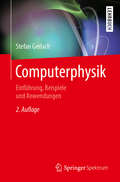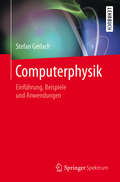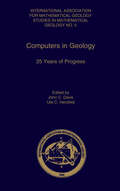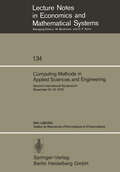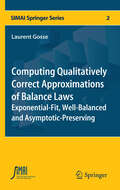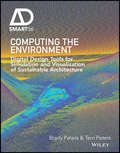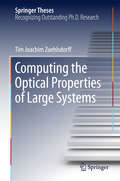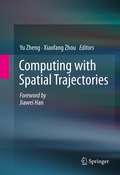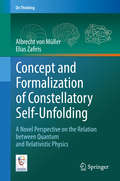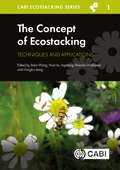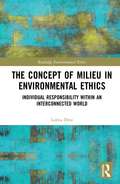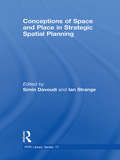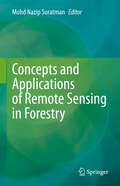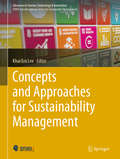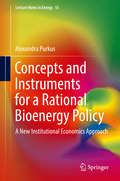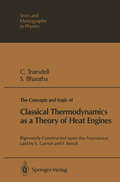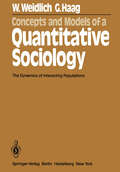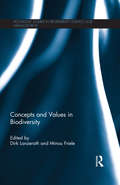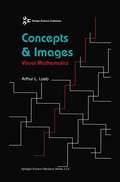- Table View
- List View
Computerphysik: Einführung, Beispiele und Anwendungen
by Stefan GerlachDieses Lehrbuch bietet dem Leser eine aktuelle Einführung in das Lösen von physikalischen Problemen mit dem Computer. Die Grundlagen der Computernutzung, der Programmierung sowie der wichtigsten numerischen Methoden werden besprochen und anhand vieler Beispiele und Übungsaufgaben mit zunehmendem Bezug zur Physik verdeutlicht. Die Nutzung des Betriebssystems Linux und die Programmierung in C und Python bilden dabei die Schwerpunkte.Der wichtigste Teil des Buches umfasst die Projekte, in denen die zuvor besprochenen Grundlagen auf unterschiedliche Probleme der Physik angewendet werden. Die Projekte beinhalten viele wichtige Beispiele aus der Computerphysik (u.a. den Oszillator und Anfangswertprobleme) und diskutieren deren Anwendungen im Detail. Der Leser erhält damit das nötige Rüstzeug, um selbstständig physikalische Probleme mithilfe des Computers zu lösen. Zahlreiche Übungsaufgaben unterstützen beim Vertiefen des Erlernten.Neben einer Vielzahl an kleinen Ergänzungen und Verbesserungen ist die zweite Auflage um ein zusätzliches Projektkapitel zum Thema Daten- und Signalanalyse erweitert, wobei wichtige Themen wie statistische Methoden, Filtermethoden und Bildanalyse behandelt werden.Dieses Buch ist in erster Linie für Bachelorstudenten der Physik, aber auch anderer naturwissenschaftlicher Fächer gedacht. Es kann aber auch von Lehrern und Dozenten zur eigenen Vorbereitung genutzt werden. Vorkenntnisse auf dem Gebiet setzt dieses Buch nicht voraus. Nur in den Projekten wird auf Wissen aus den Grundvorlesungen der Physik zurückgegriffen.
Computerphysik: Einführung, Beispiele und Anwendungen
by Stefan GerlachDieses Lehrbuch bietet dem Leser eine aktuelle Einführung in das Lösen von physikalischen Problemen mit dem Computer. Es werden die Grundlagen der Computernutzung, der Programmierung sowie der wichtigsten numerischen Methoden besprochen und anhand vieler Beispiele und Übungsaufgaben mit zunehmendem Bezug zur Physik verdeutlicht. Die Nutzung des Betriebssystems Linux und die Programmierung in C und Python bilden dabei den Schwerpunkt. Der wichtigste Teil des Buches sind die Projekte, in denen die zuvor besprochenen Grundlagen auf unterschiedliche Probleme der Physik angewendet werden. Die Projekte umfassen viele wichtige Beispiele aus der Computerphysik (u.a. den Oszillator und Anfangswertprobleme) und diskutieren deren Anwendungen im Detail. Der Leser erhält damit das nötige Rüstzeug, um selbstständig physikalische Probleme mit Hilfe des Computers zu lösen. Zahlreiche Übungsaufgaben helfen dabei.
Computers in Geology: 25 Years of Progress (International Association for Mathematical Geology Studies in Mathematical Geology)
by John C. Davis Ute Christina HerzfeldThis volume vividly demonstrates the importance and increasing breadth of quantitative methods in the earth sciences. With contributions from an international cast of leading practitioners, chapters cover a wide range of state-of-the-art methods and applications, including computer modeling and mapping techniques. Many chapters also contain reviews and extensive bibliographies which serve to make this an invaluable introduction to the entire field. In addition to its detailed presentations, the book includes chapters on the history of geomathematics and on R.G.V. Eigen, the "father" of mathematical geology. Written to commemorate the 25th anniversary of the International Association for Mathematical Geology, the book will be sought after by both practitioners and researchers in all branches of geology.
Computing Methods in Applied Sciences and Engineering: Second International Symposium December 15–19, 1975 (Lecture Notes in Economics and Mathematical Systems #134)
by J. L. Lions R. GlowinskiIRIA LABORIA, Institut de Recherche d'Informatique et d'Automatique
Computing Qualitatively Correct Approximations of Balance Laws: Exponential-Fit, Well-Balanced and Asymptotic-Preserving (SEMA SIMAI Springer Series #2)
by Laurent GosseSubstantial effort has been drawn for years onto the development of (possibly high-order) numerical techniques for the scalar homogeneous conservation law, an equation which is strongly dissipative in L1 thanks to shock wave formation. Such a dissipation property is generally lost when considering hyperbolic systems of conservation laws, or simply inhomogeneous scalar balance laws involving accretive or space-dependent source terms, because of complex wave interactions. An overall weaker dissipation can reveal intrinsic numerical weaknesses through specific nonlinear mechanisms: Hugoniot curves being deformed by local averaging steps in Godunov-type schemes, low-order errors propagating along expanding characteristics after having hit a discontinuity, exponential amplification of truncation errors in the presence of accretive source terms... This book aims at presenting rigorous derivations of different, sometimes called well-balanced, numerical schemes which succeed in reconciling high accuracy with a stronger robustness even in the aforementioned accretive contexts. It is divided into two parts: one dealing with hyperbolic systems of balance laws, such as arising from quasi-one dimensional nozzle flow computations, multiphase WKB approximation of linear Schrödinger equations, or gravitational Navier-Stokes systems. Stability results for viscosity solutions of onedimensional balance laws are sketched. The other being entirely devoted to the treatment of weakly nonlinear kinetic equations in the discrete ordinate approximation, such as the ones of radiative transfer, chemotaxis dynamics, semiconductor conduction, spray dynamics or linearized Boltzmann models. “Caseology” is one of the main techniques used in these derivations. Lagrangian techniques for filtration equations are evoked too. Two-dimensional methods are studied in the context of non-degenerate semiconductor models.
Computing the Environment: Digital Design Tools for Simulation and Visualisation of Sustainable Architecture (AD Smart)
by Brady Peters Terri PetersComputing the Environment presents practical workflows and guidance for designers to get feedback on their design using digital design tools on environmental performance. Starting with an extensive state-of-the-art survey of what top international offices are currently using in their design projects, this book presents detailed descriptions of the tools, algorithms, and workflows used and discusses the theories that underlie these methods. Project examples from Transsolar Klimaengineering, Buro Happold´s SMART Group, Behnish Behnisch Architects, Thomas Herzog, Autodesk Research are contextualized with quotes and references to key thinkers in this field such as Eric Winsberg, Andrew Marsh, Michelle Addington and Ali Malkawi.
Computing the Environment: Digital Design Tools for Simulation and Visualisation of Sustainable Architecture (AD Smart)
by Brady Peters Terri PetersComputing the Environment presents practical workflows and guidance for designers to get feedback on their design using digital design tools on environmental performance. Starting with an extensive state-of-the-art survey of what top international offices are currently using in their design projects, this book presents detailed descriptions of the tools, algorithms, and workflows used and discusses the theories that underlie these methods. Project examples from Transsolar Klimaengineering, Buro Happold´s SMART Group, Behnish Behnisch Architects, Thomas Herzog, Autodesk Research are contextualized with quotes and references to key thinkers in this field such as Eric Winsberg, Andrew Marsh, Michelle Addington and Ali Malkawi.
Computing the Optical Properties of Large Systems (Springer Theses)
by Tim Joachim ZuehlsdorffThis work addresses the computation of excited-state properties of systems containing thousands of atoms. To achieve this, the author combines the linear response formulation of time-dependent density functional theory (TDDFT) with linear-scaling techniques known from ground-state density-functional theory. This extends the range of TDDFT, which on its own cannot tackle many of the large and interesting systems in materials science and computational biology. The strengths of the approach developed in this work are demonstrated on a number of problems involving large-scale systems, including exciton coupling in the Fenna-Matthews-Olson complex and the investigation of low-lying excitations in doped p-terphenyl organic crystals.
Computing with Spatial Trajectories
by Yu Zheng Xiaofang ZhouSpatial trajectories have been bringing the unprecedented wealth to a variety of research communities. A spatial trajectory records the paths of a variety of moving objects, such as people who log their travel routes with GPS trajectories. The field of moving objects related research has become extremely active within the last few years, especially with all major database and data mining conferences and journals. Computing with Spatial Trajectories introduces the algorithms, technologies, and systems used to process, manage and understand existing spatial trajectories for different applications. This book also presents an overview on both fundamentals and the state-of-the-art research inspired by spatial trajectory data, as well as a special focus on trajectory pattern mining, spatio-temporal data mining and location-based social networks. Each chapter provides readers with a tutorial-style introduction to one important aspect of location trajectory computing, case studies and many valuable references to other relevant research work. Computing with Spatial Trajectories is designed as a reference or secondary text book for advanced-level students and researchers mainly focused on computer science and geography. Professionals working on spatial trajectory computing will also find this book very useful.
Concept and Formalization of Constellatory Self-Unfolding: A Novel Perspective on the Relation between Quantum and Relativistic Physics (On Thinking)
by Albrecht Von Müller Elias ZafirisThis volume offers a fundamentally different way of conceptualizing time and reality. Today, we see time predominantly as the linear-sequential order of events, and reality accordingly as consisting of facts that can be ordered along sequential time. But what if this conceptualization has us mistaking the “exhausts” for the “real thing”, i.e. if we miss the best, the actual taking place of reality as it occurs in a very differently structured, primordial form of time, the time-space of the present? In this new conceptual framework, both the sequential aspect of time and the factual aspect of reality are emergent phenomena that come into being only after reality has actually taken place. In the new view, facts are just the “traces” that the actual taking place of reality leaves behind on the co-emergent “canvas’’ of local spacetime. Local spacetime itself emerges only as facts come into being – and only facts can be adequately localized in it. But, how does reality then actually occur? It is conceived as a “constellatory self-unfolding”, characterized by strong self-referentiality, and taking place in the primordial form of time, the not yet sequentially structured “time-space of the present”. Time is seen here as an ontophainetic platform, i.e. as the stage on which reality can first occur. This view of time (and, thus, also space) seems to be very much in accordance with what we encounter in quantum physics before the so-called collapse of the wave function. In parallel, classical and relativistic physics largely operate within the factual portrait of reality, and the sequential aspect of time, respectively. Only singularities constitute an important exemption: here the canvas of local spacetime – that emerged together with factization – melts down again. In the novel framework quantum reduction and singularities can be seen and addressed as inverse transitions: In quantum physical state reduction reality “gains” the chrono-ontological format of facticity, and the sequential aspect of time becomes applicable. In singularities, by contrast, the inverse happens: Reality loses its local spacetime formation and reverts back into its primordial, pre-local shape – making in this way the use of causality relations, Boolean logic and the dichotomization of subject and object obsolete. For our understanding of the relation between quantum and relativistic physics this new view opens up fundamentally new perspectives: Both are legitimate views of time and reality, they just address very different chrono-ontological portraits, and thus should not lead us to erroneously subjugating one view under the other. The task of the book is to provide a formal framework in which this radically different view of time and reality can be addressed properly. The mathematical approach is based on the logical and topological features of the Borromean Rings. It draws upon concepts and methods of algebraic and geometric topology – especially the theory of sheaves and links, group theory, logic and information theory, in relation to the standard constructions employed in quantum mechanics and general relativity, shedding new light on the pestilential problems of their compatibility. The intended audience includes physicists, mathematicians and philosophers with an interest in the conceptual and mathematical foundations of modern physics.
The Concept of Ecostacking: Techniques and Applications (Ecostacking Series)
by Heikki M.T. Hokkanen Dr Ingeborg Menzler-Hokkanen James D Blande Fanny Boerave Dr Daniel Carrillo Tomislav Cernava Xiaoyulong Chen Wen-Qiang Chu Gloria Gauthura Severin Hatt Jarmo K Holopainen Fathiya Khamis Pål Kvello Guang-Yun Li Dr Yaying Li Beatrice Muriithi Jinzhi Niu Levi Ombura Xian Wang Ziying Wang Qiu Yang Wei Yixia Wu Li Ya-Ying Kaijun ZhangEcostacking is a new concept and approach which aims to maximize the benefits of ecosystem service providers in cropping systems to help achieve the goal of long-term sustainable agriculture and food production. The term "ecostacking" means combining synergistically the beneficial services of functional biodiversity from all levels and types. It is a comprehensive approach, where the various ecosystem service providers are fully integrated with the rest of the cropping system including agronomic practices. It is an approach which goes beyond conventional Integrated Pest Management practises, and attempts to take advantage of all the functional biodiversity of a system. The main focus of ecostacking is on maximizing ecosystem services for biological control and pollination from beneficial arthropods, but the approach also utilizes other invertebrates (e.g., earthworms) as well as beneficial vertebrates such as bats, birds and small mammals. Microbes also provide invaluable ecosystem services including pest, disease, and weed control, either directly as components of "suppressive soils" or as plant colonizers (as endophytes or as epiphytic microbial flora). The ecostacking approach also aims to maximize other nature-provided services such as maintenance of soil health and nutrient cycling. The Concept of Ecostacking is the first book in a series which introduces ecostacking concepts to the reader and explores how this approach can be used in a variety of ways and in different cropping systems. The book defines this new concept and shows, using illustrative case studies from around the world, how ecostacking principles can be successfully employed in cropping systems in the open field, in greenhouses and in forestry. This book: · will serve as inspiration for developing further applications of this breakthrough technology for sustainable agricultural production. · is a must-read for everyone with an interest in developing sustainable crop protection systems and ecosystem management. · has been written and edited by the world's leading experts in this new and exciting endeavour.
The Concept of Milieu in Environmental Ethics: Individual Responsibility within an Interconnected World (Routledge Environmental Ethics)
by Laÿna DrozThe Concept of Milieu in Environmental Ethics discusses how we can come together to address current environmental problems at the planetary level, such as climate change, biodiversity loss, transborder pollution and desertification. The book recognises the embedded individual sociocultural and environmental contexts that impact our everyday choices. It asks, in this pluralism of worldviews, how can we build common ground to tackle environmental issues? What is our individual moral responsibility within the larger collaborative challenge? Through philosophical reasoning, this book pragmatically addresses these questions and builds a framework to support sustainable ways of living. At the core of the book, it draws on the concept of milieu (fūdo) inspired by the Japanese philosopher Watsuji Tetsurō, which captures how we act within and perceive our surroundings as a web of culturally, historically and geographically situated meanings and values. It argues that the milieu connects us as individuals with community, past and future history, and the natural world, providing us with common ground for global environmental ethics. This book will be an engaging and interesting read for scholars, researchers and students in environmental ethics, philosophy and sustainability.
The Concept of Milieu in Environmental Ethics: Individual Responsibility within an Interconnected World (Routledge Environmental Ethics)
by Laÿna DrozThe Concept of Milieu in Environmental Ethics discusses how we can come together to address current environmental problems at the planetary level, such as climate change, biodiversity loss, transborder pollution and desertification. The book recognises the embedded individual sociocultural and environmental contexts that impact our everyday choices. It asks, in this pluralism of worldviews, how can we build common ground to tackle environmental issues? What is our individual moral responsibility within the larger collaborative challenge? Through philosophical reasoning, this book pragmatically addresses these questions and builds a framework to support sustainable ways of living. At the core of the book, it draws on the concept of milieu (fūdo) inspired by the Japanese philosopher Watsuji Tetsurō, which captures how we act within and perceive our surroundings as a web of culturally, historically and geographically situated meanings and values. It argues that the milieu connects us as individuals with community, past and future history, and the natural world, providing us with common ground for global environmental ethics. This book will be an engaging and interesting read for scholars, researchers and students in environmental ethics, philosophy and sustainability.
Conceptions of Space and Place in Strategic Spatial Planning (RTPI Library Series)
by Simin Davoudi Ian StrangeBringing together authors from academia and practice, this book examines spatial planning at different places throughout the British Isles. Six illustrative case studies of practice examine which conceptions of space and place have been articulated, presented and visualized through the production of spatial strategies. Ranging from a large conurbation (London) to regional (Yorkshire and Humber) and national levels, the case studies give a rounded and grounded view of the physical results and the theory behind them. While there is widespread support for re-orienting planning towards space and place, there has been little common understanding about what constitutes ‘spatial planning’, and what conceptions of space and place underpin it. This book addresses these questions and stimulates debate and critical thinking about space and place among academic and professional planners.
Conceptions of Space and Place in Strategic Spatial Planning (RTPI Library Series)
by Simin Davoudi Ian StrangeBringing together authors from academia and practice, this book examines spatial planning at different places throughout the British Isles. Six illustrative case studies of practice examine which conceptions of space and place have been articulated, presented and visualized through the production of spatial strategies. Ranging from a large conurbation (London) to regional (Yorkshire and Humber) and national levels, the case studies give a rounded and grounded view of the physical results and the theory behind them. While there is widespread support for re-orienting planning towards space and place, there has been little common understanding about what constitutes ‘spatial planning’, and what conceptions of space and place underpin it. This book addresses these questions and stimulates debate and critical thinking about space and place among academic and professional planners.
Concepts and Applications of Remote Sensing in Forestry
by Mohd Nazip SuratmanThis edited book is a collection of information on recent advancements in remote sensing for forestry application. The main focus of this book is to address the novel applications in remote sensing in terms of recent techniques, sensors, methods and data collection. Remote sensing has been used for many decades. Today, remote sensing is heavily utilized in forest management, which is acquired from airborne and space-borne platforms using satellite data. In recent years, there have been rapid advances in the new types of sensors. The new generations of satellite sensors are introduced not only to provide important information on forest ecosystems, but also to improve the techniques and accuracies obtained by the traditional approaches. Researchers have become increasingly aware of the potential of remote sensing to address important forestry issues and challenges. The number of forestry publications using remote sensing has grown very rapidly, and this is noticeable with many recent technologies and applications. This book provides valuable source of reference to foresters, researchers, ecologists, climate change scientists and scholars who use remote sensing in their work. Furthermore, it serves as an academic book for undergraduate and graduate students of forestry, agriculture, natural resources and environmental sciences. The book demonstrates and engages the students how the new advancements in remote sensing technology and theory relate to the many real-world forestry applications. It gives readers deeper understanding on how remote sensing has come a long way and evolved into a mature science in the past five decades.
Concepts and Approaches for Sustainability Management (Advances in Science, Technology & Innovation)
by Khai Ern LeeWith the introduction of the 2030 Agenda for Sustainable Development by the United Nations General Assembly in 25 September 2015, UN agencies, member states and stakeholders have begun to focus on the adoption and implementation of these strategies in realization of 17 Sustainable Development Goals. To work toward sustainability, strategic measures to encourage stakeholders to contribute to the goals of the 2030 agenda are needed. In recognition of these efforts, this book is produced to compile research concepts and approaches for the area of sustainability management of industry, technology development, community, education and the environment. The objective of this book is to deliberate concepts and approaches of sustainability management taking place in Malaysia whereby case studies will be revealed to provide way forward of sustainability management toward achieving sustainable development. The insights provided can be applied to advanced and developing countries by sustainable development practitioners, encompassing government agencies, academia, industries, NGOs and community, who would like to adopt the concept of approach of sustainability into their area of management.
Concepts and Instruments for a Rational Bioenergy Policy: A New Institutional Economics Approach (Lecture Notes in Energy #55)
by Alexandra PurkusThis book provides an in-depth economic analysis of the challenges associated with bioenergy use and production. Drawing on New Institutional Economics and the theory of economic policy, it develops theory-based recommendations for a bioenergy policy that strives for efficiency and sustainability. Further, it shows how to deal with diverse uncertainties and constraints, such as institutional path dependencies, transaction costs, multiple and conflicting policy aims, and interacting market failures, while also applying the resulting theoretical insights to a case study analysis of Germany’s bioenergy policy. As such, the book aims to bridge the gap between practical bioenergy policymaking on the one hand, and neoclassical theory-based concepts that strictly focus on a minimization of greenhouse gas mitigation costs on the other.
The Concepts and Logic of Classical Thermodynamics as a Theory of Heat Engines: Rigorously Constructed upon the Foundation Laid by S. Carnot and F. Reech (Theoretical and Mathematical Physics)
by Clifford A. Truesdell Subramanyam BharathaMon but n'a jamais be de m'occuper des ces matieres comme physicien, mais seulement comme /ogicien ... F. REECH, 1856 I do not think it possible to write the history of a science until that science itself shall have been understood, thanks to a clear, explicit, and decent logical structure. The exuberance of dim, involute, and undisciplined his torical essays upon classical thermodynamics reflects the confusion of the theory itself. Thermodynamics, despite its long history, has never had the benefit of a magisterial synthesis like that which EULER gave to hydro dynamics in 1757 or that which MAXWELL gave to electromagnetism in 1873; the expositions in the works of discovery in thermodynamics stand a pole apart from the pellucid directness of the notes in which CAUCHY presented his creation and development of the theory of elasticity from 1822 to 1845. Thermodynamics was born in obscurity and disorder, not to say confusion, and there the common presentations of it have remained. With this tractate I aim to provide a simple logical structure for the classical thermodynamics of homogeneous fluid bodies. Like any logical structure, it is only one of many possible ones. I think it is as simple and pretty as can be.
Concepts and Models of a Quantitative Sociology: The Dynamics of Interacting Populations (Springer Series in Synergetics #14)
by W. Weidlich G. HaagWhile the volumes hitherto published in the Springer Series in Synergetics have been devoted almost exclusively to the self-organized formation of structures in physics, chemistry and biology, the present monograph by Weidlich and Haag deals with the formation of "structures" (or "patterns") in society. At first glance it would seem a daring enterprise to deal with the complex processes in society using concepts and methods first developed in physics. But over the past decade it has been shown that there is a large class of phenomena in a variety of fields to which unifying concepts can be applied. This is particulary true of situations in which a system composed of many parts or individuals acquires a new structure on macroscopic scales. Indeed, this is the definition of synergetics which I formulated more than a decade ago, and which formed the basis of my survey on the profound analogies in the behaviour of complex systems, includ ing those of sociology (H. Haken: Synergetics. An Introduction, Volume 1 of this series). As I have pointed out on many occasions, the universal validity of these concepts is neither accidental nor is it caused by a mere extension of physical rules to other fields, but is instead a consequence of deep-rooted struc tural properties of systems of interacting parts which are due to rigorous mathe maticallaws. Generally speaking, concepts and methods originally used in physics can be applied to sociological phenomena in two ways.
Concepts and Results in Chaotic Dynamics: A Short Course (Theoretical and Mathematical Physics)
by Pierre Collet Jean-Pierre EckmannThe study of dynamical systems is a well established field. This book provides a panorama of several aspects of interest to mathematicians and physicists. It collects the material of several courses at the graduate level given by the authors, avoiding detailed proofs in exchange for numerous illustrations and examples. Apart from common subjects in this field, a lot of attention is given to questions of physical measurement and stochastic properties of chaotic dynamical systems.
Concepts and Values in Biodiversity (Routledge Studies in Biodiversity Politics and Management)
by Dirk Lanzerath Minou FrieleBiodiversity may refer to the diversity of genes, species or ecosystems in general. These varying concepts of biodiversity occasionally lead to conflicts among researchers and policy makers, as each of them require a customized type of protection strategy. This book addresses the questions surrounding the merits of conserving an existing situation, evolutionary development or the intentional substitution of one genome, species or ecosystem for another. Any practical steps towards the protection of biodiversity demand a definition of that which is to be protected and, in turn, the motivations for protecting biodiversity. Is biodiversity a necessary model which is also useful, or does it carry intrinsic value? Debates like this are particularly complex when interested parties address it from different conceptual and moral perspectives. Comprised of three parts, each complemented by a short introductory paragraph, this collection presents a variety of approaches to this challenge. The chapters cover the perspectives of environmental scientists with expertise in evolutionary, environmental biology, systematic zoology and botany, as well as those of researchers with expertise in philosophy, ethics, politics, law and economics. This combination facilitates a truly interdisciplinary debate by highlighting hitherto unacknowledged implications that inform current academic and political debates on biodiversity and its protection. The book should be of interest to students and researchers of environment studies, biodiversity, environmental philosophy, ethics and management.
Concepts and Values in Biodiversity (Routledge Studies in Biodiversity Politics and Management)
by Dirk Lanzerath Minou FrieleBiodiversity may refer to the diversity of genes, species or ecosystems in general. These varying concepts of biodiversity occasionally lead to conflicts among researchers and policy makers, as each of them require a customized type of protection strategy. This book addresses the questions surrounding the merits of conserving an existing situation, evolutionary development or the intentional substitution of one genome, species or ecosystem for another. Any practical steps towards the protection of biodiversity demand a definition of that which is to be protected and, in turn, the motivations for protecting biodiversity. Is biodiversity a necessary model which is also useful, or does it carry intrinsic value? Debates like this are particularly complex when interested parties address it from different conceptual and moral perspectives. Comprised of three parts, each complemented by a short introductory paragraph, this collection presents a variety of approaches to this challenge. The chapters cover the perspectives of environmental scientists with expertise in evolutionary, environmental biology, systematic zoology and botany, as well as those of researchers with expertise in philosophy, ethics, politics, law and economics. This combination facilitates a truly interdisciplinary debate by highlighting hitherto unacknowledged implications that inform current academic and political debates on biodiversity and its protection. The book should be of interest to students and researchers of environment studies, biodiversity, environmental philosophy, ethics and management.
Concepts & Images: Visual Mathematics (Design Science Collection)
by Arthur Loeb1. Introduction . 1 2. Areas and Angles . . 6 3. Tessellations and Symmetry 14 4. The Postulate of Closest Approach 28 5. The Coexistence of Rotocenters 36 6. A Diophantine Equation and its Solutions 46 7. Enantiomorphy. . . . . . . . 57 8. Symmetry Elements in the Plane 77 9. Pentagonal Tessellations . 89 10. Hexagonal Tessellations 101 11. Dirichlet Domain 106 12. Points and Regions 116 13. A Look at Infinity . 122 14. An Irrational Number 128 15. The Notation of Calculus 137 16. Integrals and Logarithms 142 17. Growth Functions . . . 149 18. Sigmoids and the Seventh-year Trifurcation, a Metaphor 159 19. Dynamic Symmetry and Fibonacci Numbers 167 20. The Golden Triangle 179 21. Quasi Symmetry 193 Appendix I: Exercise in Glide Symmetry . 205 Appendix II: Construction of Logarithmic Spiral . 207 Bibliography . 210 Index . . . . . . . . . . . . . . . . . . . . 225 Concepts and Images is the result of twenty years of teaching at Harvard's Department of Visual and Environmental Studies in the Carpenter Center for the Visual Arts, a department devoted to turning out students articulate in images much as a language department teaches reading and expressing one self in words. It is a response to our students' requests for a "handout" and to l our colleagues' inquiries about the courses : Visual and Environmental Studies 175 (Introduction to Design Science), YES 176 (Synergetics, the Structure of Ordered Space), Studio Arts 125a (Design Science Workshop, Two-Dimension al), Studio Arts 125b (Design Science Workshop, Three-Dimensional),2 as well as my freshman seminars on Structure in Science and Art.
